Instagram Stories offer a dynamic platform for brands to engage audiences and capture leads through creative content and interactive features. By implementing consistent branding and strategic posting, businesses can enhance viewer engagement and drive conversions effectively. Tracking key metrics allows brands to refine their approach and better understand audience preferences.
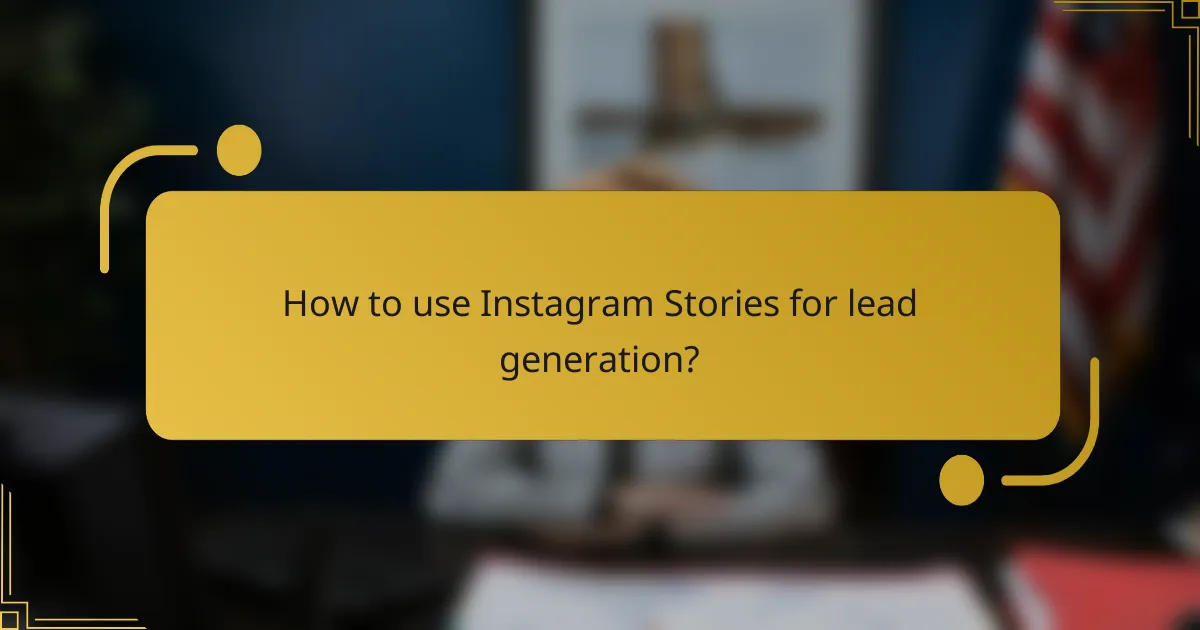
How to use Instagram Stories for lead generation?
Instagram Stories can effectively generate leads by engaging users with compelling content and clear calls to action. By leveraging interactive features and creative formats, brands can capture audience interest and drive them toward conversion.
Engaging content formats
Utilizing diverse content formats is crucial for keeping your audience engaged on Instagram Stories. Options include images, videos, boomerangs, and GIFs, each offering unique ways to present your message. For instance, short videos can showcase products in action, while eye-catching images can highlight special promotions.
Consider incorporating storytelling elements to create a narrative that resonates with your audience. This could involve sharing customer testimonials or behind-the-scenes glimpses of your brand. The more relatable and authentic your content, the more likely it is to foster engagement and lead generation.
Call-to-action strategies
Effective call-to-action (CTA) strategies are essential for guiding viewers toward taking the next step. Use clear and direct language, such as “Swipe up to learn more” or “Tap to shop now,” to prompt immediate responses. Position your CTAs strategically within your Stories to maximize visibility and impact.
Experiment with different CTAs to see what resonates best with your audience. For example, you might try offering exclusive discounts or limited-time offers to create urgency. Regularly analyze your engagement metrics to refine your approach and improve lead capture over time.
Utilizing polls and questions
Polls and questions are powerful tools for increasing interaction and gathering insights from your audience. By asking questions or creating polls, you invite viewers to participate, making them feel more connected to your brand. This engagement can lead to higher conversion rates as users become more invested in your offerings.
Consider using polls to gauge interest in new products or services, or ask open-ended questions to encourage feedback. For example, you might ask, “What features do you want in our next product?” This not only engages your audience but also provides valuable data to inform your marketing strategies.
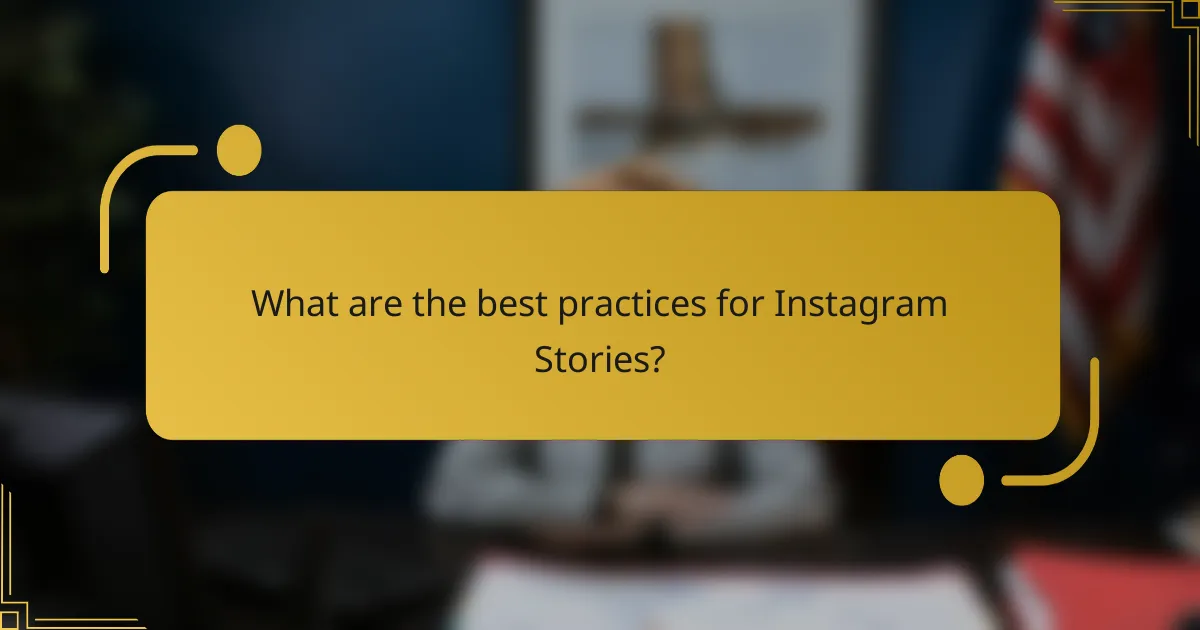
What are the best practices for Instagram Stories?
To maximize the effectiveness of Instagram Stories, focus on consistent branding, optimal posting frequency, and utilizing story highlights for retention. These practices enhance engagement and help capture leads effectively.
Consistent branding
Consistent branding in Instagram Stories involves using the same colors, fonts, and logos across your content. This creates a cohesive look that strengthens brand recognition and trust among your audience.
Incorporate brand elements like your logo or specific color palettes in every story. For example, if your brand colors are blue and white, ensure these colors dominate your stories to create a familiar visual identity.
Optimal posting frequency
Finding the right posting frequency for Instagram Stories is crucial for maintaining audience engagement. Generally, posting 3 to 10 stories per day can keep your audience interested without overwhelming them.
Monitor engagement metrics to adjust your frequency. If you notice a drop in views or interactions, consider reducing the number of stories or varying the content type to keep it fresh and appealing.
Story highlights for retention
Story highlights allow you to save important stories on your profile, making them accessible beyond the usual 24-hour lifespan. This feature is essential for retaining key content that showcases your brand’s offerings or important announcements.
Organize highlights into categories, such as “Products,” “Testimonials,” or “Events,” to make navigation easy for viewers. This not only retains interest but also encourages new followers to explore your brand’s story and offerings effectively.
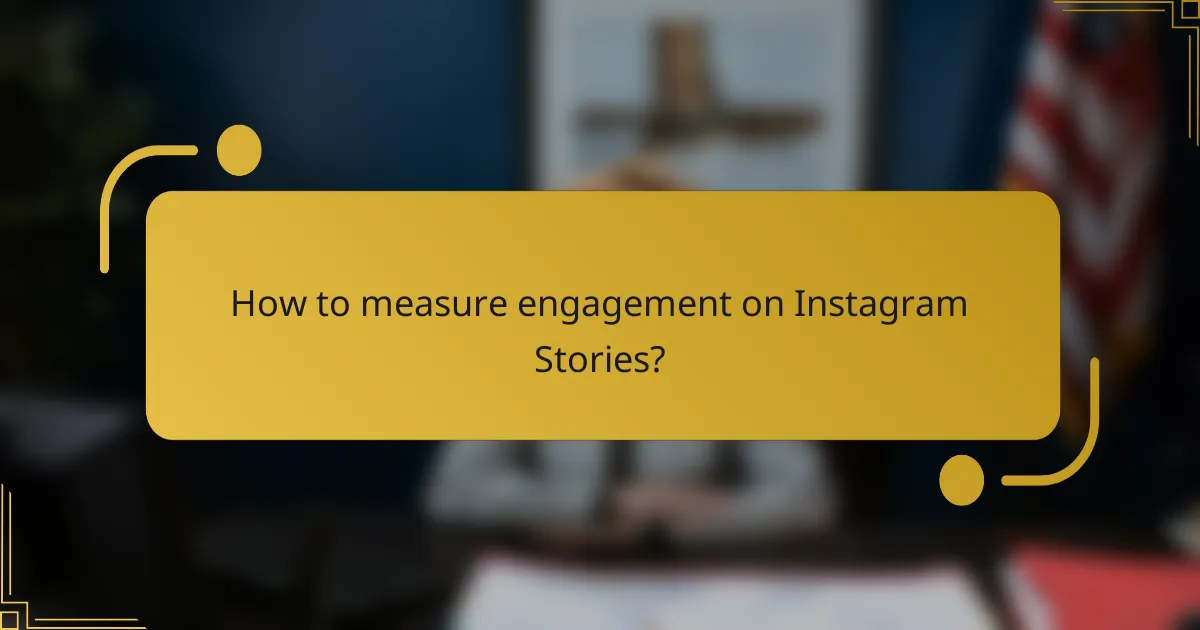
How to measure engagement on Instagram Stories?
Measuring engagement on Instagram Stories involves tracking how viewers interact with your content through various metrics. Key indicators include views, replies, shares, and sticker interactions, which provide insights into audience interest and content effectiveness.
Analytics tools overview
Instagram provides built-in analytics for business accounts, allowing users to access data on story performance directly within the app. Additionally, third-party tools like Hootsuite and Sprout Social offer more detailed analytics, including audience demographics and engagement trends over time.
These tools typically present data in user-friendly dashboards, making it easier to visualize performance metrics. Choose a tool that aligns with your specific needs, whether it’s basic tracking or comprehensive analysis.
Key performance indicators
Key performance indicators (KPIs) for Instagram Stories include reach, impressions, and engagement rate. Reach indicates how many unique users viewed your story, while impressions show the total number of times your story was viewed, including repeat views.
Engagement rate can be calculated by dividing the total interactions (replies, shares, sticker taps) by the number of views. A high engagement rate generally suggests that your content resonates well with your audience.
Interpreting engagement metrics
Interpreting engagement metrics requires understanding the context of the data. For instance, a high number of views but low interactions may indicate that your content is not compelling enough to prompt action. Conversely, a lower reach with high engagement suggests a targeted audience that finds your content valuable.
Regularly review these metrics to identify trends over time. Look for patterns in what types of content generate the most engagement, and adjust your strategy accordingly to enhance future stories.

What creative tools enhance Instagram Stories?
Creative tools can significantly enhance the quality and engagement of Instagram Stories. Utilizing design, video editing, and template applications can help users create visually appealing content that captures attention and drives interaction.
Canva for design
Canva is a versatile design tool that allows users to create stunning graphics for Instagram Stories. With a user-friendly interface, it offers a wide range of customizable templates, fonts, and images, making it easy to produce professional-looking designs.
To get started, select an Instagram Story template and customize it with your branding elements, such as colors and logos. Keep in mind that using high-quality images and a consistent style can enhance brand recognition and viewer engagement.
InShot for video editing
InShot is a powerful video editing app that enables users to create dynamic videos for Instagram Stories. It offers features like trimming, merging, and adding music or text overlays, which can elevate the storytelling aspect of your content.
When using InShot, aim for videos that are between 15 to 30 seconds long to maintain viewer interest. Additionally, consider incorporating engaging transitions and effects to make your videos more captivating.
StoryArt for templates
StoryArt provides a variety of pre-designed templates specifically for Instagram Stories, making it easy to create visually cohesive content. The app includes numerous styles and themes that cater to different aesthetics and brand identities.
To maximize the effectiveness of StoryArt, choose templates that align with your brand’s voice and message. Experiment with different layouts and color schemes to find what resonates best with your audience, and remember to keep text minimal for clarity.
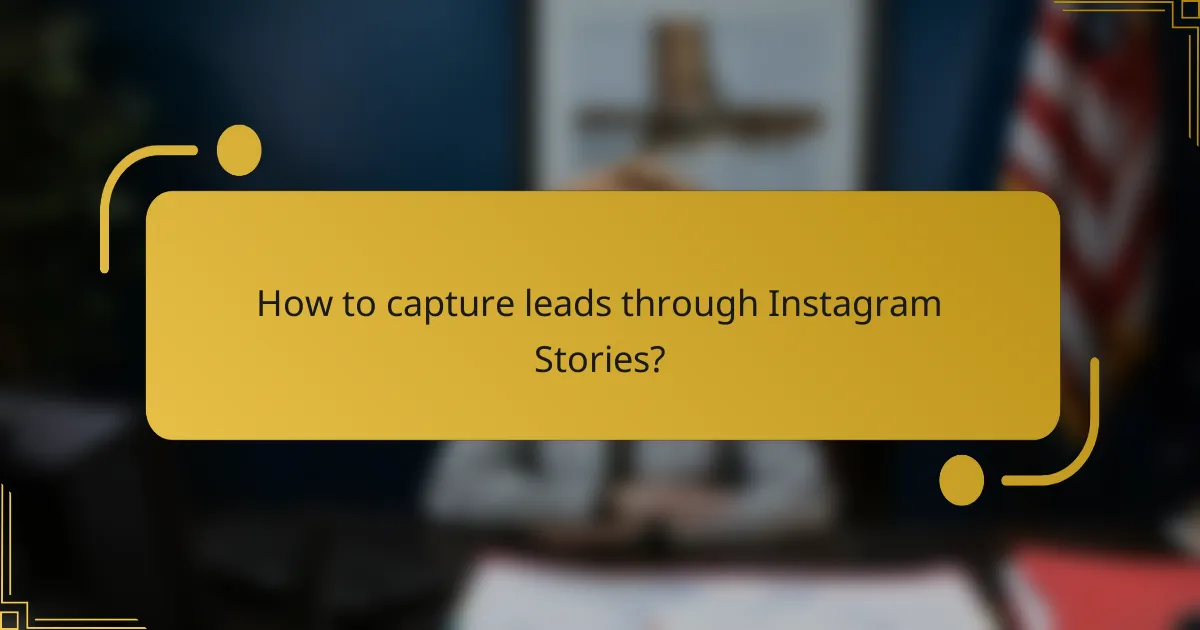
How to capture leads through Instagram Stories?
Capturing leads through Instagram Stories involves strategically using features like links, engaging content, and effective tools to convert viewers into potential customers. By leveraging these elements, businesses can enhance their engagement and drive traffic to lead capture forms.
Linking to landing pages
Linking to landing pages is a direct method to capture leads via Instagram Stories. You can add a link sticker that directs users to a specific page where they can sign up or learn more about your offerings. Ensure that the landing page is optimized for mobile devices, as most Instagram users access the platform through their smartphones.
Keep the landing page simple and focused, with a clear call to action. For example, if you’re promoting a webinar, your landing page should highlight the benefits of attending and include an easy sign-up form. Aim for a conversion rate of around 20-30% to gauge effectiveness.
Using lead magnets
Lead magnets are incentives offered to potential customers in exchange for their contact information. Common examples include free eBooks, discount codes, or exclusive content. Promote these lead magnets through your Instagram Stories to entice viewers to take action.
When creating a lead magnet, ensure it provides real value to your audience. For instance, if you run a fitness brand, offering a free workout plan can attract users interested in fitness. Use a clear and compelling visual in your Stories to highlight the lead magnet and encourage sign-ups.
Integrating with CRM systems
Integrating your lead capture efforts on Instagram Stories with a Customer Relationship Management (CRM) system streamlines the process of managing leads. This integration allows you to automatically collect and organize contact information from users who engage with your Stories.
Choose a CRM that offers automation features to save time and reduce errors. For example, platforms like HubSpot or Salesforce can help you track interactions and follow up with leads effectively. Ensure that your CRM is compliant with data protection regulations, such as GDPR, to maintain user trust.
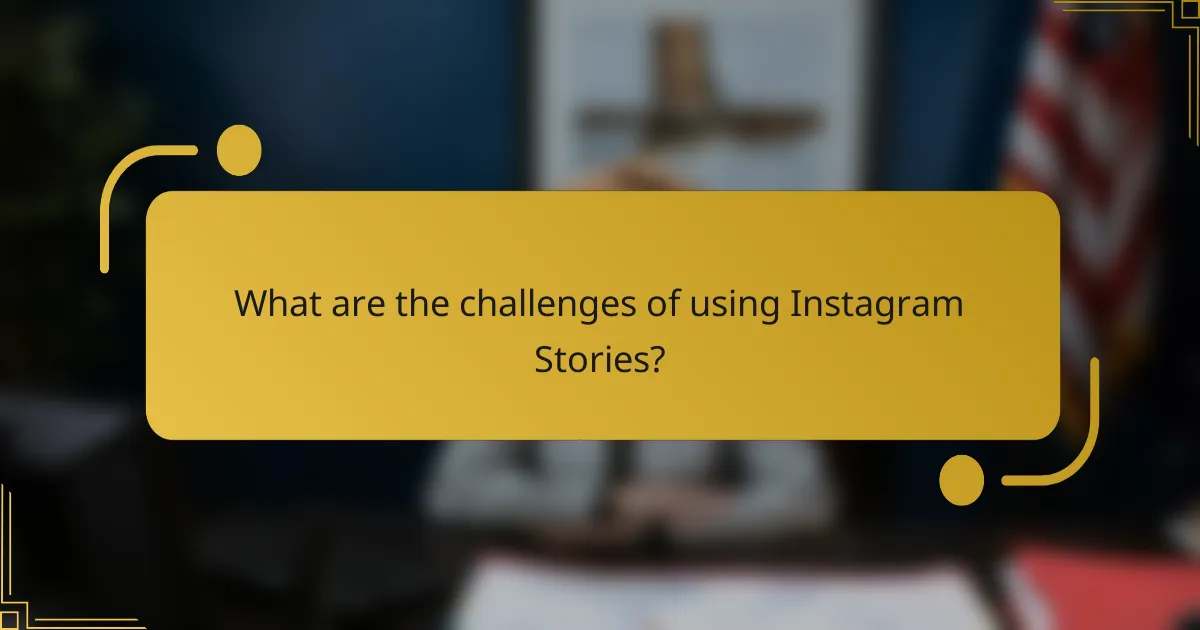
What are the challenges of using Instagram Stories?
Using Instagram Stories presents several challenges, including content saturation, engagement retention, and the need for consistent creativity. Brands must navigate these hurdles to effectively capture audience attention and drive engagement.
Content saturation
Content saturation occurs when users are overwhelmed by the sheer volume of stories shared on Instagram. With millions of stories uploaded daily, standing out becomes increasingly difficult for brands and creators alike.
To combat content saturation, focus on creating unique, high-quality stories that resonate with your target audience. Consider using eye-catching visuals, compelling narratives, and interactive elements like polls or questions to engage viewers.
Regularly analyze your audience’s preferences and adjust your content strategy accordingly. Experiment with different formats, such as behind-the-scenes footage or user-generated content, to maintain interest and encourage interaction.



